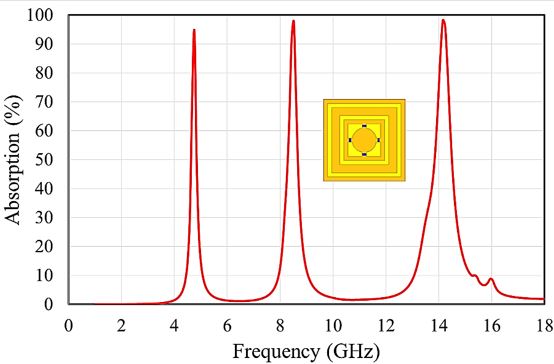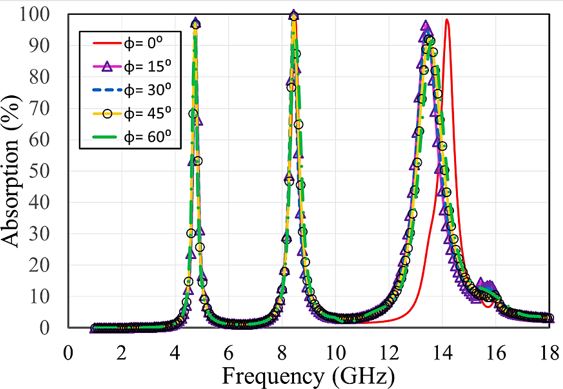Ultrathin Polarization Insensitive Dual/Triple Band Reconfigurable Metamaterial Microwave Absorber for C, X and Ku Band Applications
Sood D1*
DOI:10.5281/zenodo.11044286
1* Deepak Sood, University Institute of Engineering and Technology and Kurukshetra University Kurukshetra, Haryana, India.
A polarization independent dual/triple band metamaterial microwave absorber is designed and characterized. The absorber design comprise two square loop resonators and a circularly slotted square patch resonator designed with 0.03 mm thick copper plate. These resonators are separated by 1.56 mm thick FR4 dielectric from back annealed 0.03mm thick continuous copper plate. The simulated responses derived using HFSS shows that the intended absorber exhibits three absorption peaks at 4.75, 8.52 and 14.16 GHz with an absorption of 94.5%, 97.6% and 98.2%, respectively. The electrical dimensions of the unit cell are 0.158λ × 0.158λ computed at 4.75 GHz. The designed structure is polarization independent due to four-fold symmetric design configuration and therefore exhibit the same absorption response for both TE and TM polarizations for normal incident of the EM wave. The absorption response for oblique incidence angles has also been examined for both polarizations and the absorber exhibit above 80% absorption at oblique angles of incidence. Further, the designed is made frequency reconfigurable by embedding RF switches at circularly slotted square patch resonator. At off conditions of the switches, the design shows dual band behavior (for C, X) which makes it a potential candidate for reconfigurable RF applications such as RCS reduction, energy harvesting, wireless communication and sensors etc.
Keywords: metamaterial absorber, reconfigurable, multiband, rf switching
| Corresponding Author | How to Cite this Article | To Browse |
|---|---|---|
| , , , University Institute of Engineering and Technology and Kurukshetra University Kurukshetra, Haryana, , India. Email: |
Sood D, Ultrathin Polarization Insensitive Dual/Triple Band Reconfigurable Metamaterial Microwave Absorber for C, X and Ku Band Applications. Appl. Sci. Eng. J. Adv. Res.. 2023;2(2):35-40. Available From https://asejar.singhpublication.com/index.php/ojs/article/view/95 |


 ©
© 




